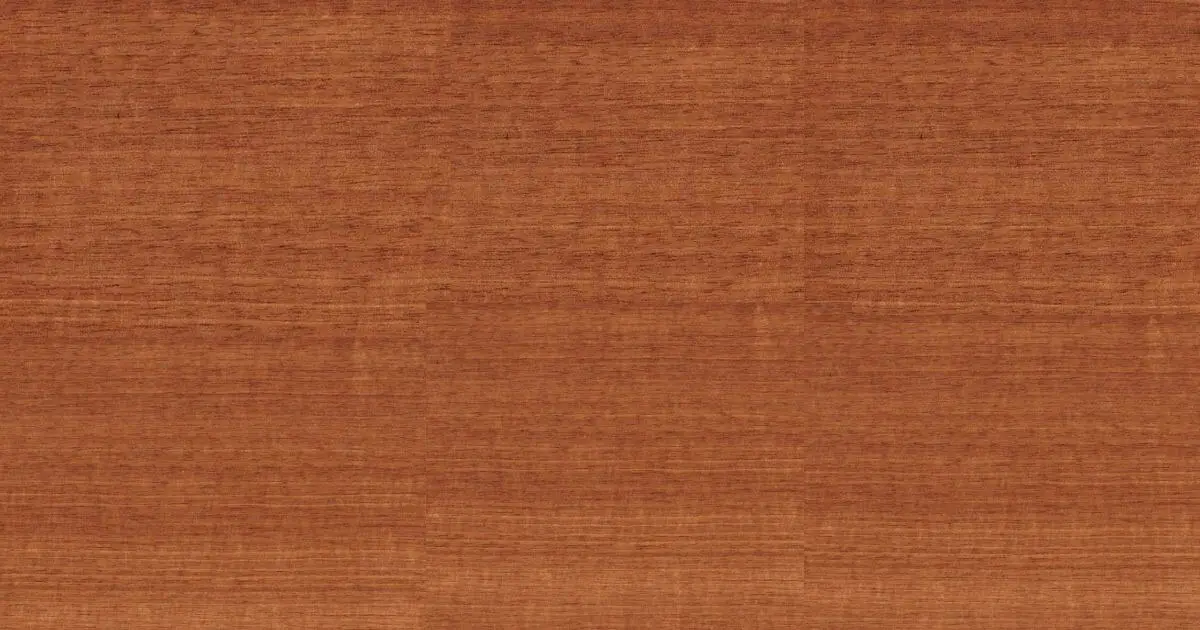Makore (Tighemella hecklii) is a pink or reddish brown colored hardwood native to tropical regions of West and Central Africa. The Makore tree is mainly distributed in Cameroon, Gabon, and Congo.
Makore is a large evergreen tree that can grow up to 200 feet tall. Under favorable conditions, the average growth rate of a Makore tree is about 1 to 2 feet (30 to 60 cm) per year.
| Scientific name | Tieghemella heckelii |
| Tree Size: | 150-200 ft (46-60 m) tall, 4-6 ft (1.2-1.8 m) diameter |
| Wood Color | Pink or reddish brown |
| Average Dried Weight: | 42.9 lbs/ft3 (685 kg/m3) |
| Janka Hardness: | 1,200 lbf (5,350 N) |
| Pricing | Moderate |
| Workability | Easy |
| Type | Hardwood |
Uses
Makore has excellent durability and appearances, making it versatile for outdoor and indoor use. Here are some common uses of Makore wood.
Furniture
Makore has a fine appearance and fine grain. It is used to make high-end furniture such as cabinets, tables, chairs, and cabinetry.
Interior Joinery
Makore is commonly used for interior architectural details, such as paneling, molding, and trim work, which add an elegant look to the interior.
Veneers
Its fine texture and consistent grain pattern make Makore wood an excellent choice for making veneers that can be applied to plywood or other substrates, providing the look of solid wood at a lower cost.
Musical Instruments
Due to its acoustic properties, Makore wood is used for musical instruments, such as guitars, pianos, and other stringed instruments.
Turning and Carving
Makore’s workability and beautiful appearance also make it suitable for woodturning and carving projects, creating intricate designs and decorative items.
Boat Interiors
It is not typically recommended for boat exteriors due to its moderate durability, Makore can be used in boat interiors where it may be protected from direct exposure to the moisture.
Appearance
The heartwood of the Makode wood can range from pinkish brown to reddish brown, while the sapwood is light brown. Makore wood, like most hardwoods, darkens over time when exposed to direct sunlight.
Hardness
Makore wood has a known hardness value of 1,200 lbf (5,350 N) and a dry weight of 42.9 lbs/ft3 (685 kg/m3). It is almost twice as hard as the Australian Red Cedar.
Here are the hardness scales of some popular wood species to give you an idea of how hard Makore wood is.
| Wood Species | Janka Hardness |
| Paper Birch | 910 lbf (4,050 N) |
| American Holly | 1,020 lbf (4,540 N) |
| Claro Walnut | 1,130 lbf (5,030 N) |
| Sweet Cherry | 1,150 lbf (5,120 N) |
| Makore Wood | 1,200 lbf (5,350 N) |
| Red oak | 1,220 lbf (5,430 N) |
| Blue Ash | 1,290 lbf (5,740 N) |
| Shagbark Hickory | 1,880 lbf (8,360 N) |
Makore Wood Pros and Cons
Makore wood is great for woodworking, but it has many advantages and drawbacks that you should be aware of before using it.
Pros
- Appearance: One of the most significant advantages of Makore wood is its appearance. Its reddish brown and uniform texture creates a beautiful and warm aesthetic look.
- Durability: Makore wood is naturally durable and stable, so it is suitable for exterior applications. Makore wood can withstand low amounts of moisture, and It requires less maintenance than many wood species.
- Easy to Work: Makore wood is easy to work with hand and machine tools, bends well compared to many other woods, and is easy to glue and finish.
- Moderate Price: Makore wood is available in the market at a moderate price, making it accessible to the woodworker or homeowner looking for quality wood.
- Versatility: Another great advantage of Makore wood is its versatility. It can be used for almost all woodworking projects.
Cons
- Allergic: Working with Makore wood can cause problems like eye, throat, and skin irritation. Therefore, take necessary precautions while working with it.
Is Makore Wood Good For Flooring?
Yes, Mekode wood is a great choice for flooring, its color makes it attractive to match your interior design, and the density makes it less prone to scratches and dents.
Is Makore wood Waterproof?
No, Makore wood is not waterproof, but it does have some natural resistance to moisture due to its dense grain and the presence of certain oils and resins.
FAQs
Is Makore wood suitable for outdoor furniture?
Yes, Makore wood is naturally durable and resistant to decay, so it is a suitable choice for outdoor furniture and structures.
How can I protect Makore wood from scratches?
To protect Makore wood from scratches and dents, use protective pads or coasters for furniture legs and avoid dragging heavy objects on the wood.
Can I use Makore wood for flooring?
While Makore wood is durable and hard. It may not be the most practical choice for flooring due to its vulnerability to scratches and potential cost considerations.

